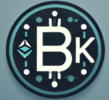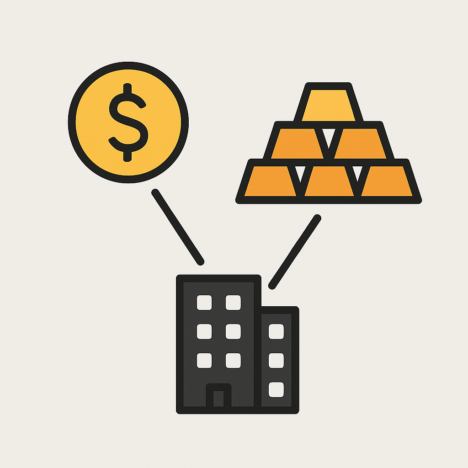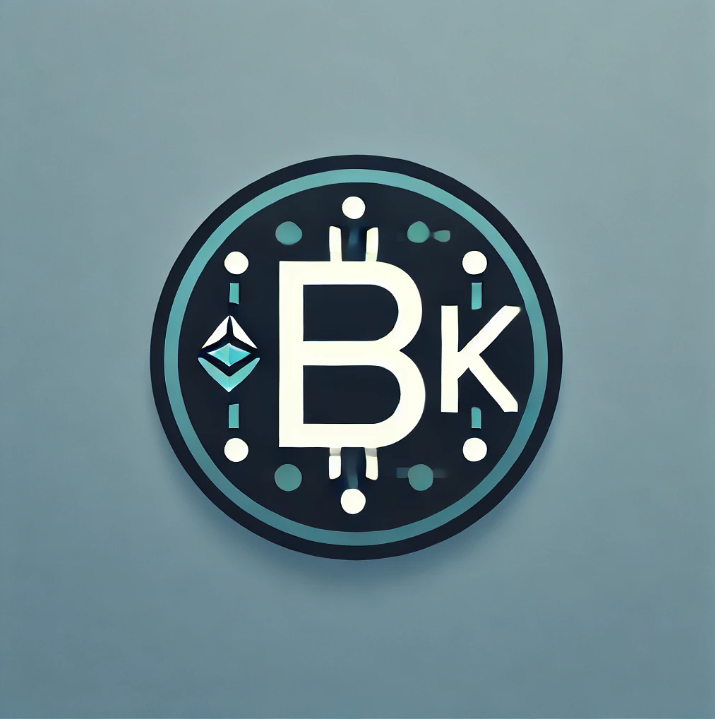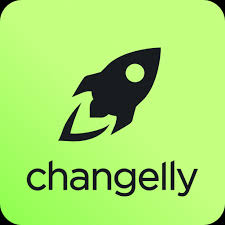Explaining the tokenization of real estate, gold, and bonds using blockchain—without the boring bits
From Meme Coins to Mortgage Deeds?
When you think “crypto,” what comes to mind?
Magic internet money. Frogs with sunglasses. JPEGs of bored apes. Wild price charts and even wilder speculation.
But lately, there’s a new phrase shaking up serious circles in the blockchain space:
Real World Assets.
Also known as RWAs, this is the idea that real stuff—like buildings, gold bars, stocks, bonds, invoices, and more—can be brought on chain using blockchain technology.
It’s not a new concept, but suddenly, everyone’s talking about it. Why?
Because RWAs might be the bridge between the volatile, sometimes absurd world of crypto… and the trillion-dollar traditional financial system that runs the global economy.
Let’s break it down:
- What are RWAs?
- How are they tokenized?
- Why is everyone suddenly paying attention?
- And what might the future of your paycheck, property, or pension look like—on chain?
🧱 What Are Real World Assets (RWAs)?
Real World Assets are exactly what they sound like: tangible or traditional financial assets that exist off-chain—in the “real world”—but are represented digitally on a blockchain.
These can include:
- Real estate
- Gold and precious metals
- Bonds and treasuries
- Invoices and receivables
- Stocks
- Fine art
- Intellectual property
- Carbon credits
When these assets are “tokenized,” they are given a digital representation on the blockchain, usually in the form of a fungible token (like a stablecoin) or a non-fungible token (NFT) with specific metadata and ownership rights.
⚙️ How Tokenization Works (Without the Technical Jargon)
Let’s say you own a warehouse in Miami. You want to tokenize it. Here’s what the process might look like:
- Legal Framework
First, you set up a legal structure that recognizes digital shares or claims on your property. - Asset Valuation
The warehouse is professionally appraised to determine its current value. - Token Creation
A smart contract is written that creates a fixed number of tokens representing shares of that warehouse (e.g., 1 token = 1 square foot). - Custody & Compliance
A custodian or legal entity is appointed to manage the physical asset and ensure that token holders have enforceable rights. - On-Chain Marketplace
The tokens are listed on a compliant marketplace where buyers can purchase, trade, or hold them. - Revenue Streams
If the warehouse generates rent, those proceeds can be distributed automatically via smart contracts to token holders.
Boom. You’ve taken a warehouse and made it tradable like crypto.
🏢 RWA Example #1: Real Estate
Real estate is often cited as the killer app for RWAs. Why?
- It’s expensive and illiquid
- Ownership is messy and bureaucratic
- You can’t easily buy 0.01% of a hotel… unless it’s tokenized
Tokenized Real Estate Use Cases:
- Fractional ownership: Buy $100 worth of a Manhattan condo
- Rental yield tokens: Get paid in stablecoins based on monthly rent
- Real estate-backed DeFi loans: Use your real estate tokens as collateral
Imagine an Airbnb property you partially own—managed by a DAO, rented through a Web3 platform, and paying yield to your wallet.
That’s not sci-fi. That’s what some RWAs aim to build.
🪙 RWA Example #2: Gold (Hard Money Meets Digital Speed)
Gold has always been the OG store of value. But carrying gold bars in your backpack? Not ideal.
Enter tokenized gold.
How It Works:
- A custodian stores physical gold in a vault
- A blockchain issues tokens representing the gold
- 1 token = 1 gram (or ounce) of gold
- You can redeem the token for actual gold—or trade it digitally
Why it matters:
- 24/7 trading
- Borderless ownership
- No need to move physical gold
- Combines the trust of gold with the speed of crypto
You get the security of precious metals without the hassle of safes, shipping, or suspicious pawn shops.
📄 RWA Example #3: Bonds and Treasuries
Here’s where things get spicy—because institutional money loves bonds.
What’s Happening:
- U.S. Treasury bills are being tokenized and made tradable on blockchain
- Stablecoin issuers are backing their reserves with real-world securities
- DeFi protocols are experimenting with tokenized treasury markets
Why It Matters:
- Crypto traders can get exposure to stable, yield-bearing assets
- Tokenized bonds offer real, audited backing for stablecoins
- Institutions can participate in DeFi without touching meme coins
In short: RWAs could be the gateway for TradFi (traditional finance) to finally dip their toes into the Web3 pool.
🧠 Why Everyone’s Suddenly Paying Attention
So, what’s fueling the recent RWA hype?
1. Stablecoin Realization
Stablecoins like USDC and USDT are, in fact, RWAs—backed by real-world assets like cash and government bonds.
People are finally realizing RWAs have already been in crypto… we just called them something else.
2. DeFi Fatigue
After DeFi Summer, airdrops, and yield farming collapsed into chaos, many are now craving “real yield.”
RWAs offer income from actual economic activity—not just token incentives.
3. Regulatory Pressure
Governments and financial institutions are starting to trust tokenized models—especially when backed by compliant custody, audits, and identity layers.
4. Token Infrastructure Is Better
We now have chains that are fast, cheap, and programmable enough to support meaningful tokenization of real-world value.
🔐 Benefits of Tokenizing RWAs
Bringing real assets on-chain offers several advantages:
✅ 1. Liquidity
Sell a fraction of your asset instead of the whole thing.
✅ 2. Accessibility
Open up investing to global participants—not just accredited insiders.
✅ 3. Transparency
Track ownership, payments, and contracts in real-time on-chain.
✅ 4. Automation
Use smart contracts to automate payments, distributions, compliance, and access.
✅ 5. Programmability
RWAs can plug into DeFi: lending, yield farming, staking, DAOs.
It’s the financial system—upgraded and composable.
🧱 But What Are the Challenges?
Tokenizing the world isn’t simple. Here are some of the hurdles:
❌ Legal Complexity
Property rights are governed by local laws. Blockchain is global. Resolving that isn’t easy.
❌ Custody Risk
You still need someone to hold the physical asset. If they disappear or default, the token means nothing.
❌ Regulatory Uncertainty
Are RWA tokens securities? Commodities? Both? Neither?
Clarity is coming… slowly.
❌ Trust
How do you verify a token really represents a bar of gold or a piece of land?
The answer: audits, transparency, oracles, and decentralized registries. But we’re still building that trust layer.
🧠 What Blockchains Are Leading the RWA Movement?
Several networks and protocols are doubling down on tokenized RWAs:
- Ethereum – The main hub for smart contracts and experimentation
- Polygon – Fast, low-cost, and partnering with real estate and government projects
- Tezos – Loved for formal verification and institutional-grade compliance
- Avalanche – Custom subnets for asset tokenization
- Stellar – Designed for tokenized payments and fiat rails
These chains are building the pipes to connect real-world value with the programmable future.
🧩 Real-World Impact: What Could This Look Like?
Let’s imagine a few scenarios in the next 5 years:
🎭 1. Your concert ticket is an NFT
No scalping. No duplicates. You resell it on-chain and the artist gets a royalty automatically.
🏠 2. Your mortgage is tokenized
Your house is broken into tokens. You sell 10% of your equity to pay off debt without moving.
💼 3. Your paycheck includes tokenized company shares
You vest equity in real-time. You trade shares peer-to-peer instantly.
📊 4. Your savings earn real yield
You hold tokenized treasuries that pay interest daily, directly into your wallet.
That’s not just “crypto.” That’s a new financial infrastructure—running on-chain, 24/7, programmable, borderless, and (hopefully) fairer.
🔭 Final Thoughts: RWAs Might Be the Bridge, Not the Destination
The real promise of crypto isn’t apes or yield farms—it’s creating systems that are fairer, faster, and more open.
RWAs are where crypto meets the real economy. They don’t abandon the legacy system—they upgrade it.
They bring real-world value into Web3.
They let DeFi touch physical things.
They make markets more liquid, accessible, and programmable.
And maybe, just maybe, they help blockchain grow up a little.
So the next time someone tells you crypto is “just speculation,” ask them if they’d like a yield-bearing, on-chain slice of a Manhattan office tower.
Because RWAs are here. They’re real. And they’re about to change everything.



